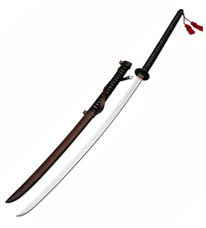One of the biggest symbols, if you can call it that, associated with feudal Japan was the samurai sword. Traditionally known as katana, the samurai sword is characterized by:
- its curved silhouette
- its association with being a fighting sword
- slim build
- sometimes reaching the length of 3 feet
- two-handed grip and
- single edged blade.
It is indeed interesting to note that the Samurai sword has a history dating back to the Edo period which spanned from the 1600s to the late 1800s.
The history of the sword
When you look at the history of sword production in Japan, it is said to span:
- till 900 AD
- 900 to 1596
- 1596-1780
- 1781 – 1876
- 1876 – 1945 and
- 1953 to the present day.
The gap in sword production between the years 1945 to 1953 was because of a ban on manufacturing. Specifically, each of these periods is characterized by a type of sword as well. So, Koto or old swords were in production from 900 to 1596. The Gendaito or modern swords were produced from 1876 to 1945. Katana by itself have a distinct history beginning from the year 1400 because this is when the swords were inscribed with the katana signature.
What is the katana signature?
Known as mei , Japanese sword signatures are a mark of identifying the sword itself – date of manufacturing, smith etc. In the year 1400, long swords were signed with the distinctive katana signature. Interestingly, with conventional swords, the signature faces away from the wearer. But with the katana, the samurai would wear it cutting edge upwards and this would result in the signature facing the other way.
Why cutting-edge up?
One of the reasons why the samurai favored the typical katana was because of the changes brought about in close combat battle. Because the cutting edge was facing upwards, the samurai could complete his lethal action of drawing and slashing at the enemy in a single movement. Furthermore, the samurai swords are also suspended from a sash tied around the waist. This facilitated the easy draw and slash movement even more.
Changing blade lengths
The history of the samurai swords can also be traced with the changes that it has gone through in terms of the blade lengths. While today, the average length is around 73 centimeters or 28.5 inches, there was a time when the blade was 60 cm or 23.5 inches in length. This was during the early 16th century. If you go back a little more in time, around the early 15th century, then the katana blades were the length of today’s blades – 73 cm.
Gendaito or modern swords were actually forbidden during the Meiji period. Samurai could not carry their swords in public. This is also a time when traditional sword makers found it extremely difficult to make a living. The modern Samurai sword and its production is governed with great strictness. Licensed sword smiths need to register their products with the Japanese government.
The history of Samurai swords or katana is an extremely interesting one indeed. For sword collectors, it would be pertinent to delve into the nuances of the story of the katana.
Author Bio
Jason has been fascinated with the Samurai swords since a very early age. Appreciated their beauty and the talent sword fighters have. He is a collector and has an impression array of swords, which makes him a true expert in this field.

